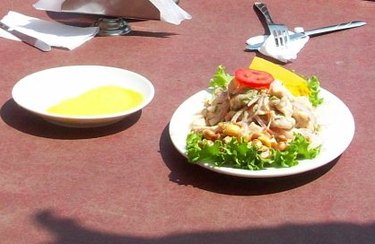
Ceviche is a delicious seafood dish. First created in the South American country of Peru, ceviche was a culinary secret that has only recently garnered international attention. Ceviche is essentially a combination of fresh fish and seafood, and lime juice. The acid in the limes "cooks" the fish. A variety of vegetables and spices are added as well. Common ingredients in addition to the fish and lime include cilantro, celery, hot peppers, onions, corn and sweet potatoes. Some people are squeamish about eating the raw fish, but they risk missing out on one of the tastiest dishes from South America.
Pre-Colombian History
Video of the Day
Ancient civilizations in Peru and Ecuador had access to fresh seafood along the coast of the southern Pacific Ocean. The Humboldt Current supplied the region with a rich variety of fish, squid and shellfish. Smaller tribes along the coast, as well as those that eventually incorporated into the mighty Inca Empire, took raw seafood and created a basic version of ceviche. They would season the raw fish with chili peppers, salt and herbs. Fruit marinades such as chicha and tumbo were used to complete this primitive dish.
Video of the Day
Spanish Arrival
Spanish explorers arrived in what is now Peru in the late 15th century. The conquistadors eventually conquered the region, destroying the Inca Empire and importing a number of culinary ingredients and practices from Europe. One of the first plants that the Spanish brought to the Americas was the Seville orange tree. They also brought lemon seeds to plant in their newly conquered territories.
A New Creation
As Spanish and indigenous cultures merged in Peru and Ecuador, the natives began to experiment with new ingredients. Cooks paired the juice of citrus fruits like lemons, limes and oranges with the fresh seafood brought in from the coast. It was then that ceviche as we know it today was first invented. It was discovered that the acid in the citrus juices added flavor and cooked the raw meat, making for a more easily digestible meal.
Throughout South America
Over the past few centuries, ceviche has evolved. Many countries in Latin America began to copy the idea and create their own variations. Most versions contain the standard seafood and lime juice, with minced hot peppers, diced red onions and chopped cilantro. In Peru, ceviche is often served with cold slices of sweet potatoes or yucca. Corn on the cob is a common side dish. Ecuador does things a bit differently, adding popcorn or nuts. Mexico has also invented its own ceviche, served on toasted tortillas.
Throughout the World
Ceviche was once a dish found only by brave travelers in South America willing to try something new. This delicious recipe has grown in popularity recently, and there are now cevicherias all around the world. These restaurants specialize in a wide variety of ceviche dishes. While ceviche remains unknown to many people in the United States and Europe, this unique culinary invention is steadily making a name for itself, plate by plate. The quality of a ceviche dish will vary greatly, depending on the restaurant where it was prepared. So don't write it off if it's less than stellar on your first try.